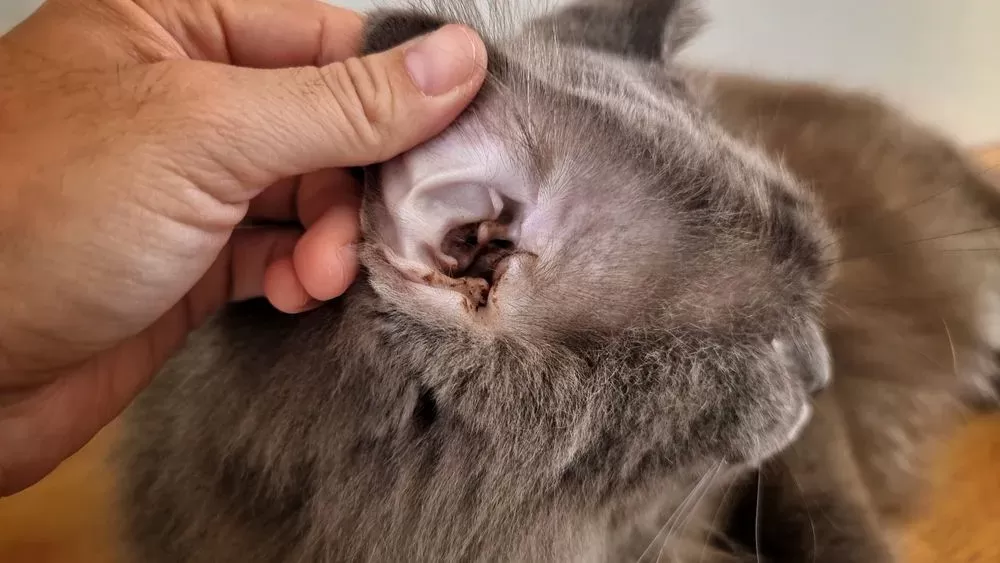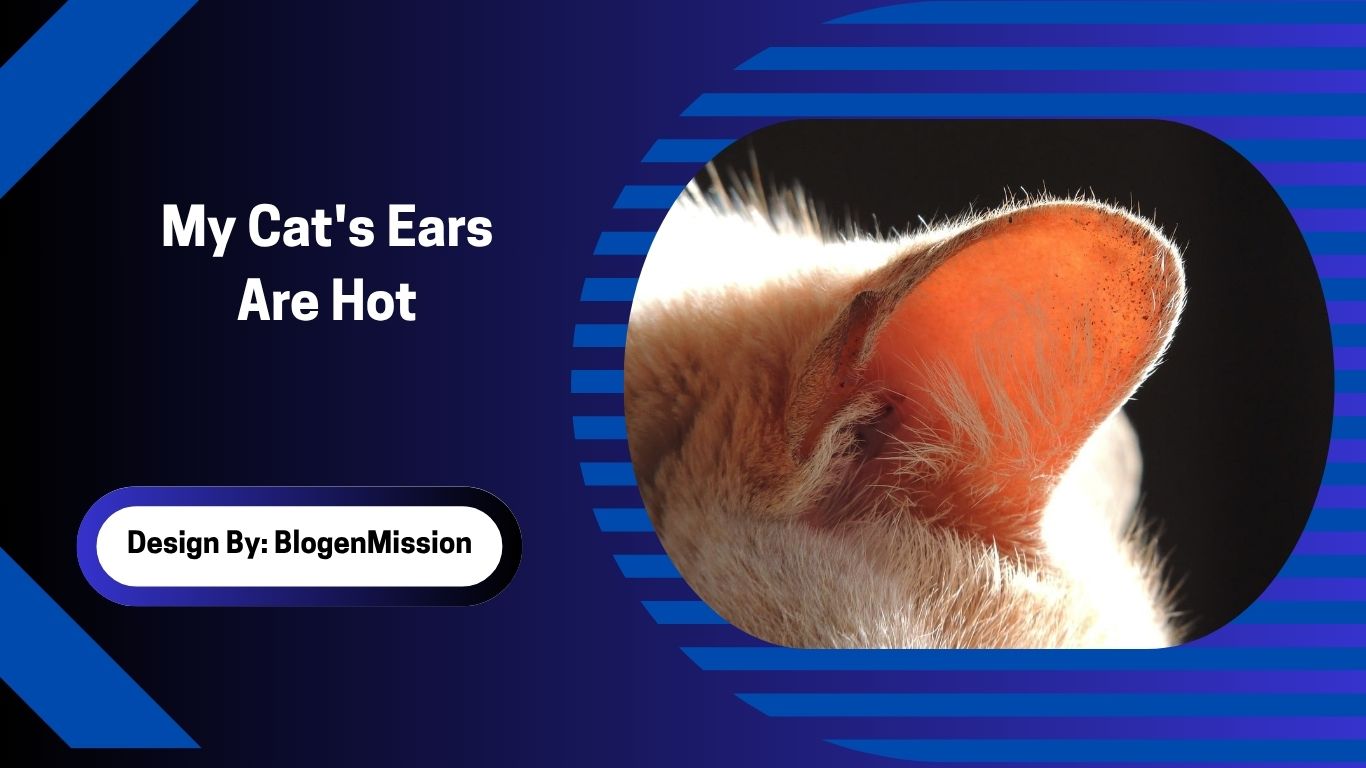Hot cat ears may signal fever, infections, mites, or allergies. Monitor symptoms like scratching or discharge, clean ears regularly, and consult a vet for proper diagnosis and treatment.
As a devoted cat owner, noticing that my cat’s ears are hot can spark concern about their feline ear health. Hot ears in cats may signal a range of issues, from minor irritations to serious feline health issues like infections or fever.
This comprehensive guide explores the reasons behind hot cat ears, common feline ear problems, and actionable steps to ensure proper cat ear care. With insights grounded in veterinary science, we’ll help you understand when to worry and how to support your cat’s well-being.
Why Are My Cat’s Ears Hot?
Cat ear temperature naturally fluctuates due to environmental factors, activity levels, or stress, but persistently hot ears may indicate underlying cat health concerns. Cats have highly vascular ears, making them sensitive to body temperature changes.
According to veterinary studies, a cat’s normal ear temperature ranges from 100°F to 103°F, but anything consistently higher could point to issues like feline fever signs or cat ear inflammation. Here are the primary reasons your cat’s ears might feel hot:
- Fever: Cat fever symptoms include hot ears, lethargy, and reduced appetite. A fever often indicates an infection or systemic illness, with body temperatures exceeding 103°F.
- Ear Infections: Cat ear infections, caused by bacteria or yeast, lead to heat, redness, and discomfort. Approximately 20% of cats experience ear infections at some point, per veterinary data.
- Ear Mites: Cat ear mites are common in kittens and outdoor cats, causing intense cat ear scratching and heat due to irritation.
- Allergies: Cat ear allergies from food, pollen, or fleas can cause feline ear redness and warmth, often accompanied by itching.
- Inflammation: Cat ear inflammation from trauma, allergies, or infections can make ears feel hot and sensitive.
- Environmental Factors: Warm weather or stress can temporarily raise cat ear temperature without serious health implications.
Understanding these causes is the first step to addressing feline ear conditions and ensuring your cat’s comfort.
Recognizing Symptoms of Feline Ear Problems

Hot ears are often accompanied by other signs that point to specific feline ear problems. Watch for these symptoms to determine if your cat needs veterinary care for cats:
- Cat Ear Scratching: Excessive scratching or head shaking may indicate cat ear mites, infections, or allergies.
- Feline Ear Redness: Red, inflamed ears suggest cat ear inflammation or allergic reactions.
- Cat Ear Swelling: Swelling could result from abscesses or hematomas caused by trauma or untreated infections.
- Cat Ear Discharge: Foul-smelling or waxy discharge is a hallmark of cat ear bacterial infection or cat ear yeast infection.
- Cat Ear Pain: If your cat flinches when you touch their ears, it may signal cat ear pain or sensitivity.
- Behavioral Changes: Lethargy, reduced appetite, or hiding can accompany feline fever signs or systemic cat health concerns.
If you notice these symptoms alongside hot cat ears, consult a veterinarian for a cat ear veterinary diagnosis to pinpoint the cause and begin appropriate treatment.
Common Causes of Hot Cat Ears
1. Cat Ear Infections
Cat ear infections are a leading cause of hot ears, often triggered by bacteria, yeast, or allergies. Cat ear bacterial infection or cat ear yeast infection can cause heat, odor, and cat ear discharge. Outdoor cats or those with long ears, like Maine Coons, are more prone. Treatment typically involves cat ear infection treatment with medicated drops, prescribed after a vet’s diagnosis.
2. Cat Ear Mites
Cat ear mites (Otodectes cynotis) affect up to 90% of kittens in multi-cat households, per veterinary research. These tiny parasites cause intense feline ear irritation, leading to hot ears and excessive scratching. Vets often prescribe topical treatments to eliminate mites and soothe cat ear sensitivity.
3. Cat Ear Allergies
Cat ear allergies from food, environmental allergens, or fleas can cause inflammation and warmth. For example, flea bites on the ears can lead to feline ear redness and heat. Identifying and eliminating allergens, along with vet-recommended antihistamines, can help.
4. Feline Fever
A fever, often linked to infections or immune responses, can make your cat’s ears feel hot. Cat fever symptoms include warm ears, lethargy, and poor appetite. A rectal temperature above 103°F confirms fever, requiring immediate veterinary care for cats.
5. Cat Ear Overheating
In warm climates or after intense play, cat ear overheating may occur temporarily. This is usually harmless unless accompanied by other symptoms like cat ear swelling or behavioral changes.
How to Check Your Cat’s Ear Health
To assess cat ear health, follow these steps safely at home:
- Observe Behavior: Note if your cat is scratching excessively or tilting their head, indicating feline ear irritation.
- Inspect Ears: Gently examine for feline ear redness, cat ear discharge, or unusual odors. Healthy ears are pale pink with minimal wax.
- Check Temperature: Compare ear warmth to the rest of the body. Persistently hot ears may require a vet visit.
- Monitor Symptoms: Track cat fever symptoms or signs of discomfort over 24-48 hours.
Avoid inserting objects into the ear canal, as this can worsen feline ear conditions. If symptoms persist, seek a cat ear veterinary diagnosis.
Cat Ear Cleaning and Home Remedies
Maintaining cat ear hygiene can prevent some causes of hot ears. Here’s how to care for your cat’s ears safely:
- Cat Ear Cleaning: Use a vet-approved ear cleaner and cotton ball to gently wipe the outer ear. Never use Q-tips, which can damage the ear canal.
- Cat Ear Home Remedies: For mild irritation, a diluted apple cider vinegar solution (1:3 with water) can soothe feline ear irritation, but consult a vet first.
- Regular Checks: Inspect ears weekly to catch early signs of cat ear mites or infections.
For serious issues like cat ear bacterial infection or cat ear yeast infection, home remedies are not enough—professional cat ear infection treatment is essential.
When to Seek Veterinary Care for Cats

Hot ears paired with symptoms like cat ear scratching, cat ear swelling, or feline fever signs warrant a vet visit. A veterinarian will:
- Perform a physical exam and otoscopy to check for feline ear problems.
- Test for cat ear mites, bacteria, or yeast using ear swabs.
- Prescribe medications like antibiotics or antifungals for cat ear infection treatment.
- Recommend allergy management or dietary changes for cat ear allergies.
Prompt veterinary care for cats can prevent complications like chronic infections or hearing loss.
Preventing Feline Ear Problems
Preventing hot cat ears and related issues involves proactive feline ear care:
- Regular Cleaning: Maintain cat ear hygiene with weekly checks and cleanings.
- Flea Control: Use vet-approved flea preventatives to avoid cat ear allergies from bites.
- Monitor Environment: Keep your cat cool in hot weather to prevent cat ear overheating.
- Healthy Diet: A balanced diet supports immune health, reducing the risk of feline health issues.
- Routine Vet Visits: Annual checkups can catch early signs of feline ear conditions.
Unique Data on Cat Ear Health
Recent veterinary studies highlight the prevalence of ear issues in cats:
- Approximately 7-10% of cats visiting vets have ear-related complaints, with cat ear infections being the most common.
- Cat ear mites account for 50-80% of ear issues in kittens, especially in multi-pet homes.
- Cats with allergies are 3 times more likely to develop cat ear inflammation, per a 2023 study in the Journal of Feline Medicine.
- Regular cat ear cleaning can reduce infection risk by up to 40%, according to vet recommendations.
These insights emphasize the importance of vigilance in maintaining cat ear health.
FAQs:
1. Can stress cause my cat’s ears to feel hot?
Yes, stress can temporarily raise cat ear temperature due to increased blood flow. Monitor for cat fever symptoms or feline ear irritation and consult a vet if heat persists.
2. How do I safely clean my cat’s ears at home?
Use a vet-approved cleaner and cotton ball to gently wipe the outer ear. Avoid Q-tips to prevent cat ear pain or damage. Consult a vet for cat ear hygiene guidance.
3. Are hot ears in cats a sign of dehydration?
Hot ears alone don’t typically indicate dehydration, but combined with lethargy or dry gums, they may signal feline health issues. Ensure fresh water and seek veterinary care for cats if concerned.
4. Can food allergies cause hot cat ears?
Yes, cat ear allergies from food can cause feline ear redness and warmth. Identify allergens with a vet’s help and switch to hypoallergenic diets to reduce cat ear inflammation.
5. How long should I monitor hot cat ears before seeing a vet?
Monitor hot cat ears for 24-48 hours. If accompanied by cat ear scratching, cat ear discharge, or lethargy, seek cat ear veterinary diagnosis immediately for proper feline ear care.
Conclusion
Hot cat ears can indicate minor issues like stress or serious feline ear problems such as cat ear infections, cat ear mites, or cat ear allergies. Regular cat ear cleaning and monitoring for symptoms like feline ear redness or cat ear scratching are crucial. Prompt veterinary care for cats ensures accurate diagnosis and treatment, preventing complications. By prioritizing feline ear health with proper care and a healthy diet, you can keep your cat comfortable and thriving for years to come.
Related Post:
- How Much Is A Pet Scan – Guide to Veterinary Pet!
- Hotels Where Pets Stay Free – Guide to Pet-Friendly Lodging!
- Pet Fix Savannah – Low-Cost Spay/Neuter!
- How Long Do Pet Allergy Symptoms Last – Comprehensive Guide!
- Can I Pet That Dog Shirt – Stylish Dog Love!
